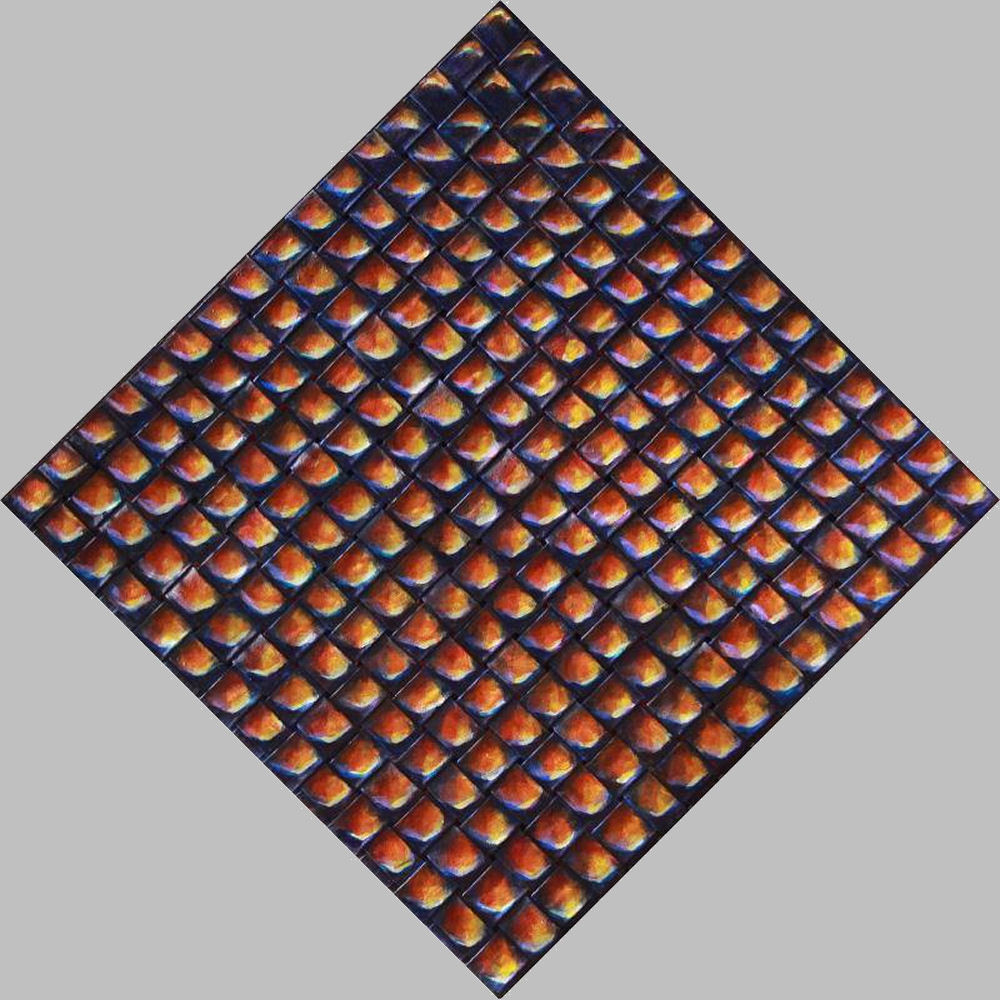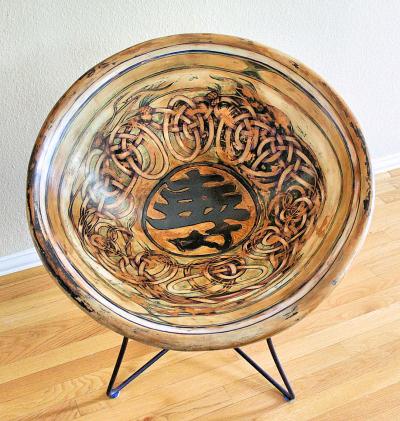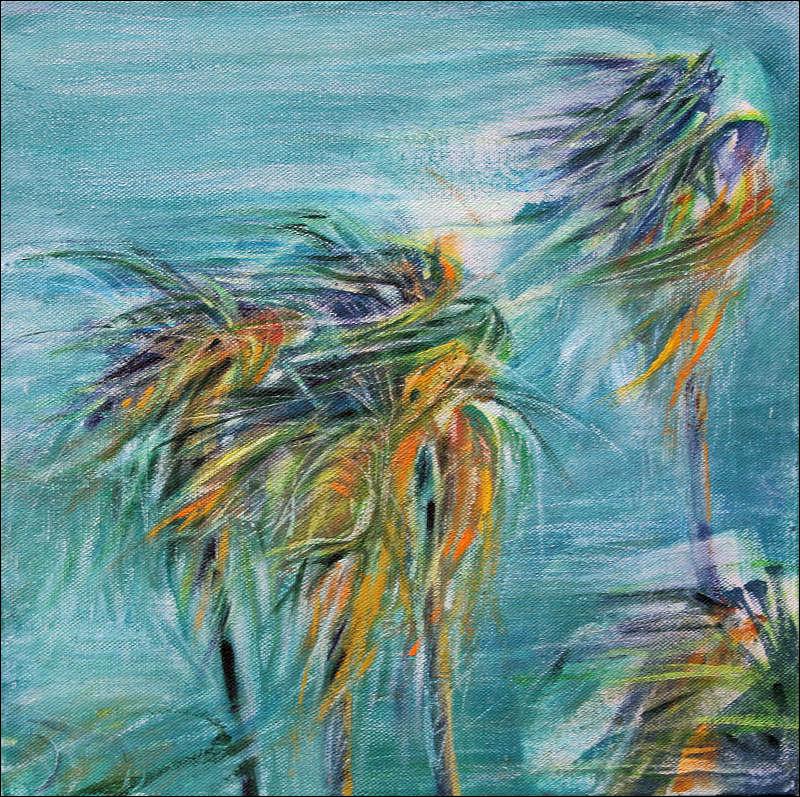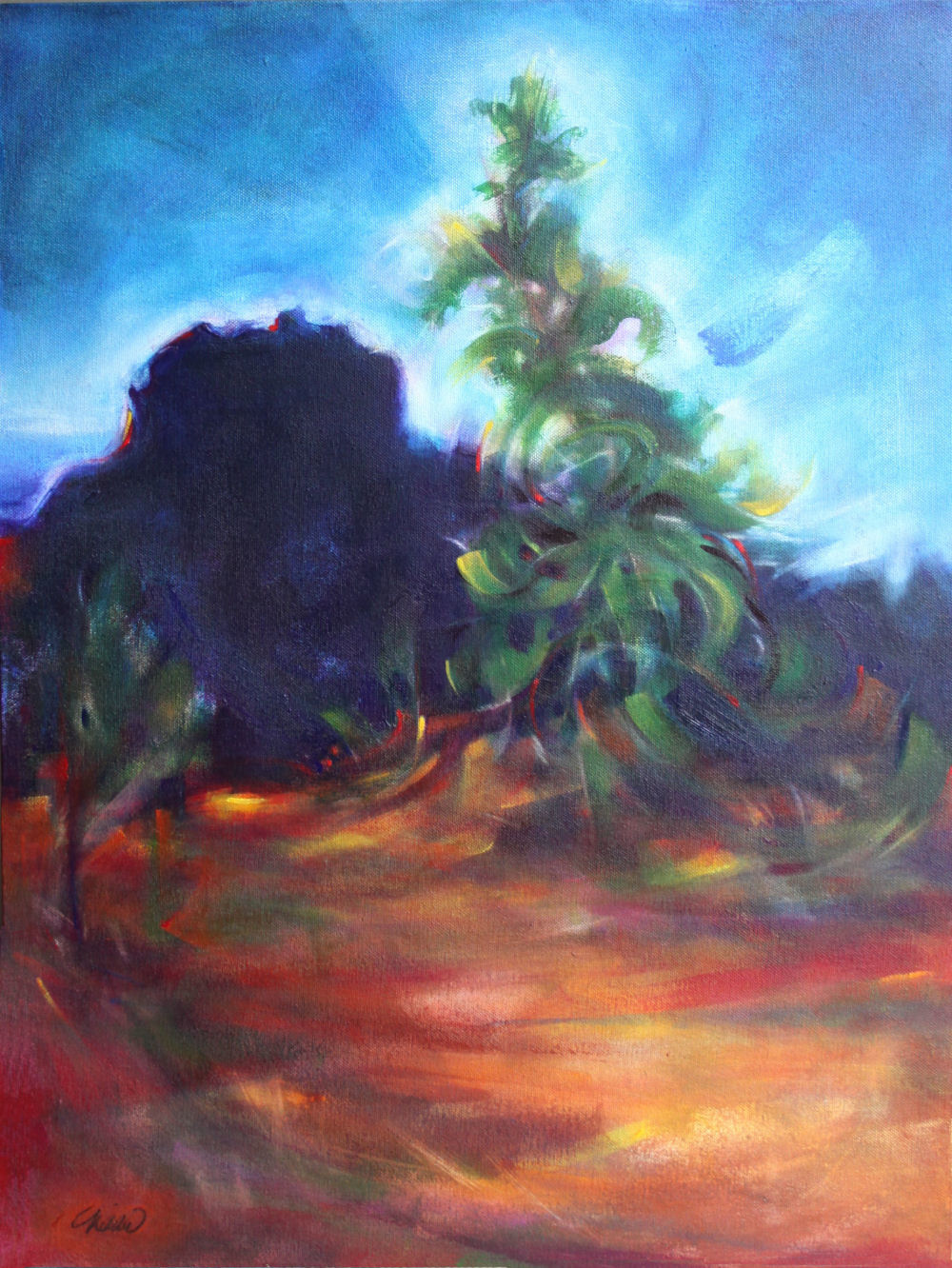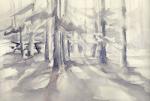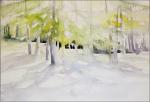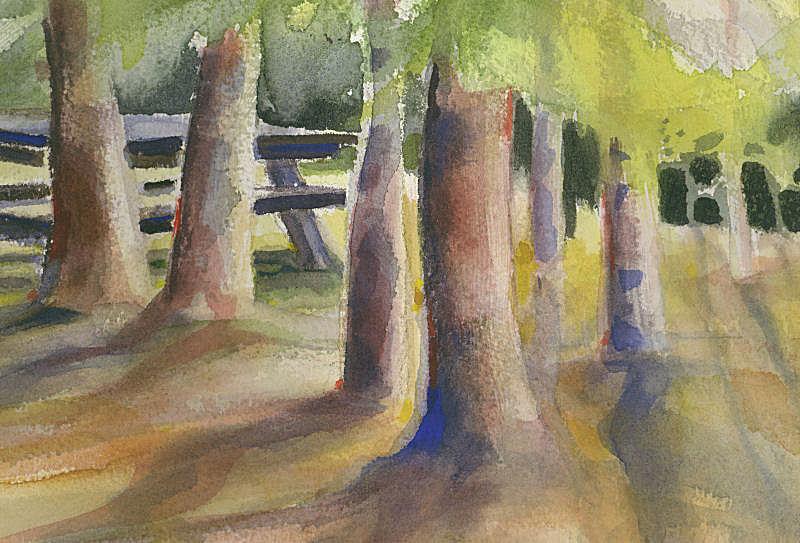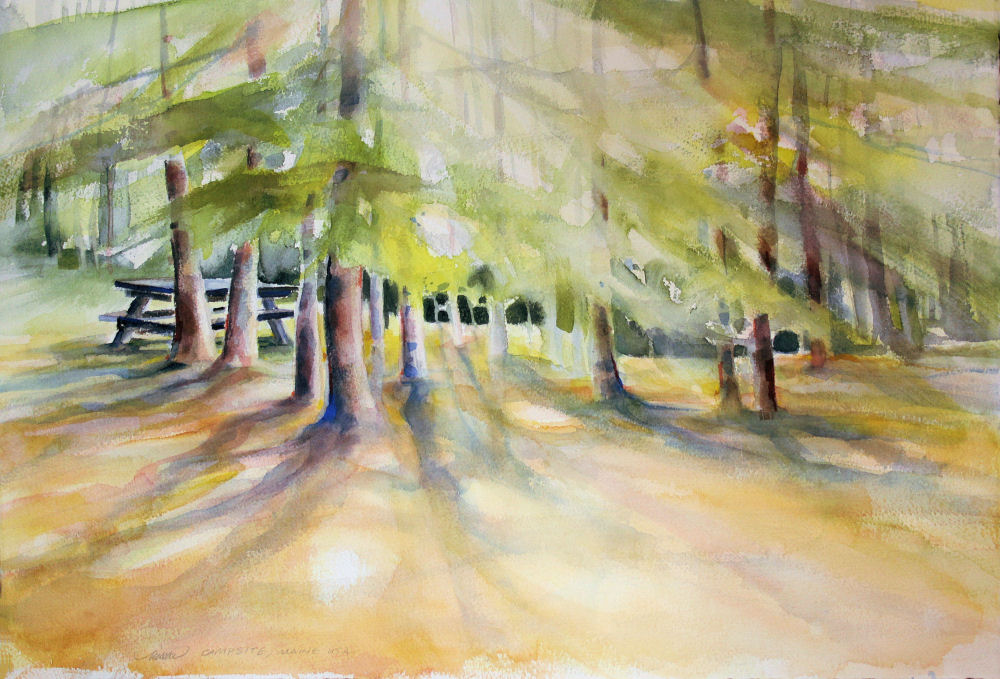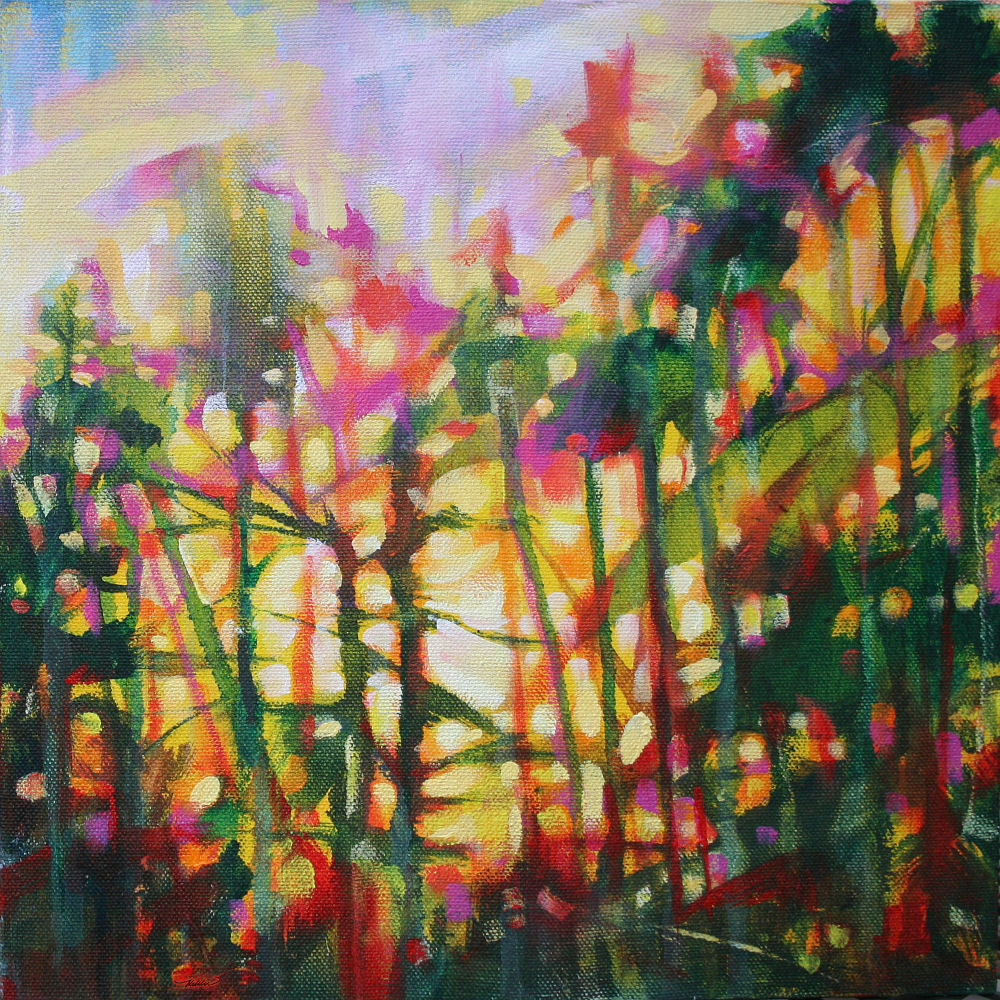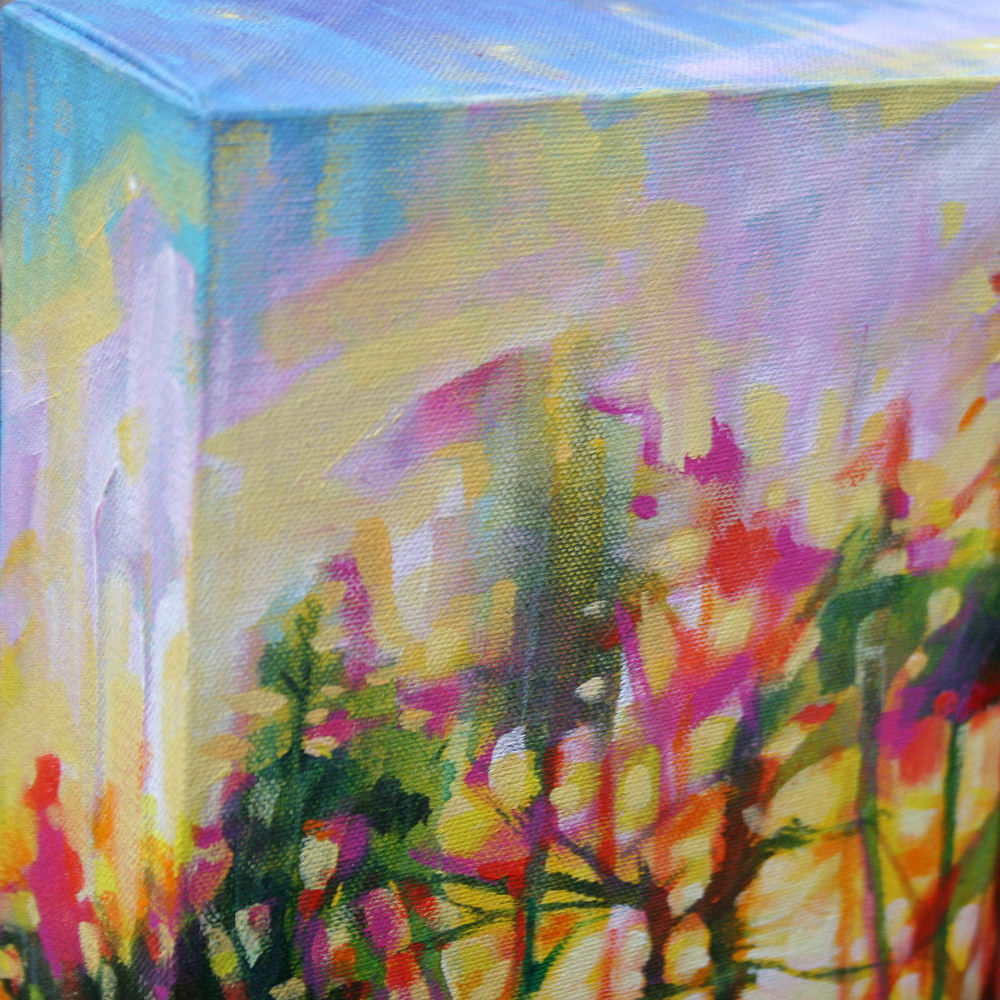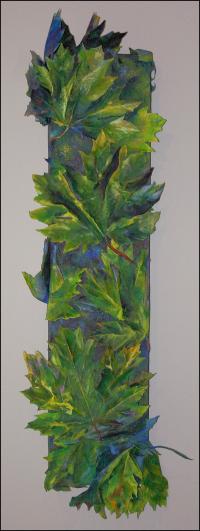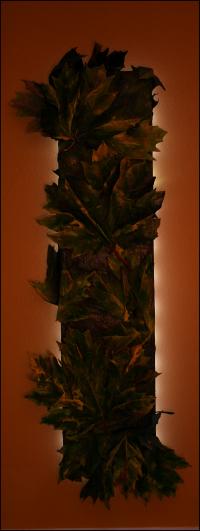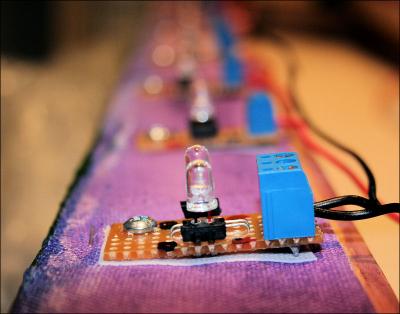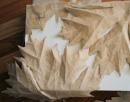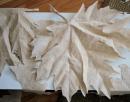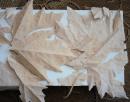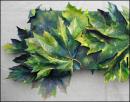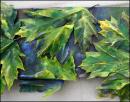Dancing With Trees Collection
« Previous Entries Next Entries »Dancing With Trees Art list for Madison, WI
Friday, April 16th, 2010
 |
 |
 |
 |
 |
 |
 |
 |
 |
 |
 |
 |
 |
 |
 |
 |
 |
 |
 |
 |
 |
 |
 |
 |
Paintings as shown are not to scale in comparison to one another
The Dancing With Trees Art Exhibition celebrates the importance of trees and forests throughout history, portraying their diversity and relationships through a variety of creative associations. Twenty three of the paintings in this collection are on exhibit in the Steinhauer Trust Gallery at the University of Wisconsin-Madison Arboretum, May 1st through June 30th, 2010. Opening Reception Saturday May 1st, 12:45 – 4:00 p.m.
All life forms on this planet proliferated, continue to flourish, and ultimately depend on the existence of trees. While the message is urgent, I consider humanity’s role on the planet as positive, with the statement that creativity is our greatest asset; that “Our carbon footprint is worthy”. Further, creative thinking is our most primal, yet highly advanced and ever-evolving contribution toward solutions to healing wrongs done and changing ingrained habits to ones that are more appreciative of the environment in general.
Purchase Art here
2D Pine Cone
Monday, April 12th, 2010
2D Pine Cone, diagonal 28 x 28 x 1 inches, acrylics on woven canvas strips, wrapped sides painted, signed on the back so as not to intrude on the design.
Norway Maple: finished, combined posts
Friday, April 9th, 2010
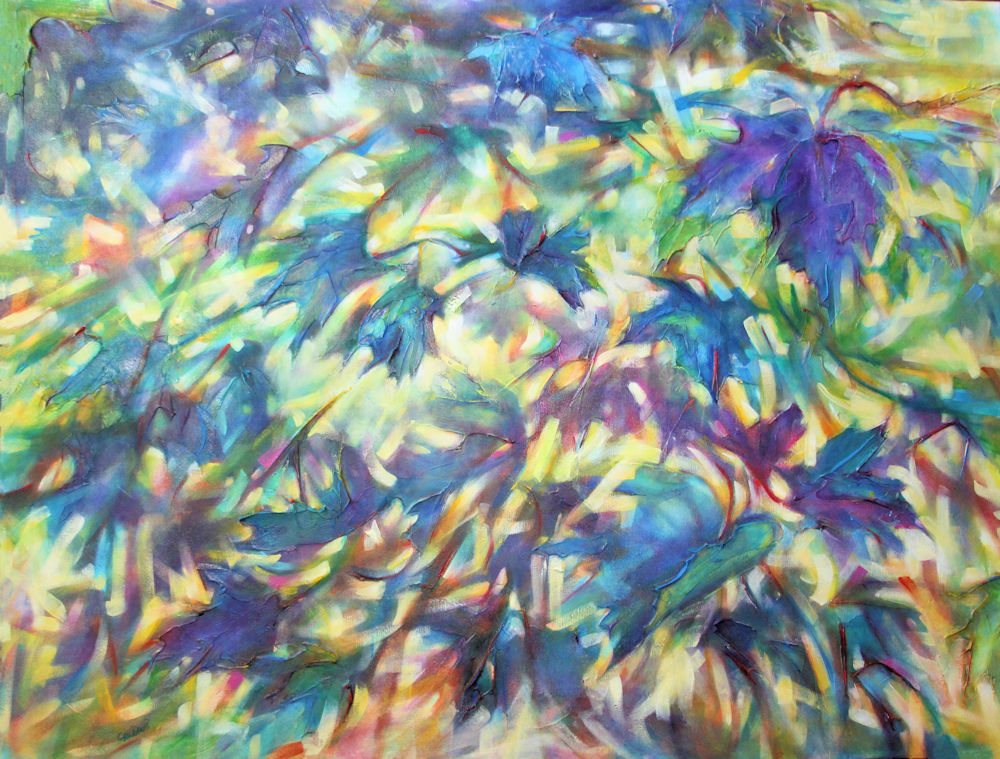
Norway Maple, 36H x 48W x 3D inches acrylics, gel paste on canvas, wrapped sides painted, navy colored narrow frame.
Thumbnails: Combined, edited posts of progression between Dec. 8th, 2009 – March, 2010. Started December 8th, 2009: modeling gel is available in varied textures, finishes and viscosity. Acrylics paint can be mixed with the medium or when dry paint can be applied over top. 3) January 18th, 2010: applying modeling paste to the base painting and sculpting with a small trowel.
 |
 |
 |
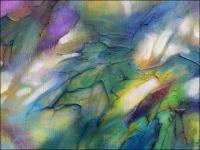 Jan. 28th:– used a dry brush so paint would catch mostly on the textures, and kept the feeling soft. Intentions are to maintain the fresh pure colors. Studied from a distance for about a week after this stage to contemplate what the next move will be.
Jan. 28th:– used a dry brush so paint would catch mostly on the textures, and kept the feeling soft. Intentions are to maintain the fresh pure colors. Studied from a distance for about a week after this stage to contemplate what the next move will be.
Feb. 27th: lighter background colors were added in order to open up the space.
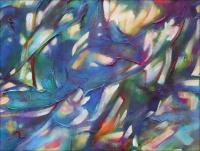
Feb. 28th: Adding a solid patch of turquoise to lower left and some tiny details like that may ground the whole thing, but that’s about it; am leaving it out of sight for a while. This really is a carnival of color, I love it!
 March 9th: Subtle changes since last post…have been working more on tones in the background which weren’t planned initially; I had hoped to use only pure colors without the usual layering, but it’s otherwise too hard to look at. Also am connecting a few shapes horizontally, and it’s almost “there”, but ‘2D Pinecone’ was started in the meantime to avoid overworking this.
March 9th: Subtle changes since last post…have been working more on tones in the background which weren’t planned initially; I had hoped to use only pure colors without the usual layering, but it’s otherwise too hard to look at. Also am connecting a few shapes horizontally, and it’s almost “there”, but ‘2D Pinecone’ was started in the meantime to avoid overworking this.
March 6th: Thanks, Virginia for taking the time to write and digitize a detailed, objective critique. I sure appreciate your opinion about what might improve this.
Learning to give critique
Wednesday, December 9th, 2009
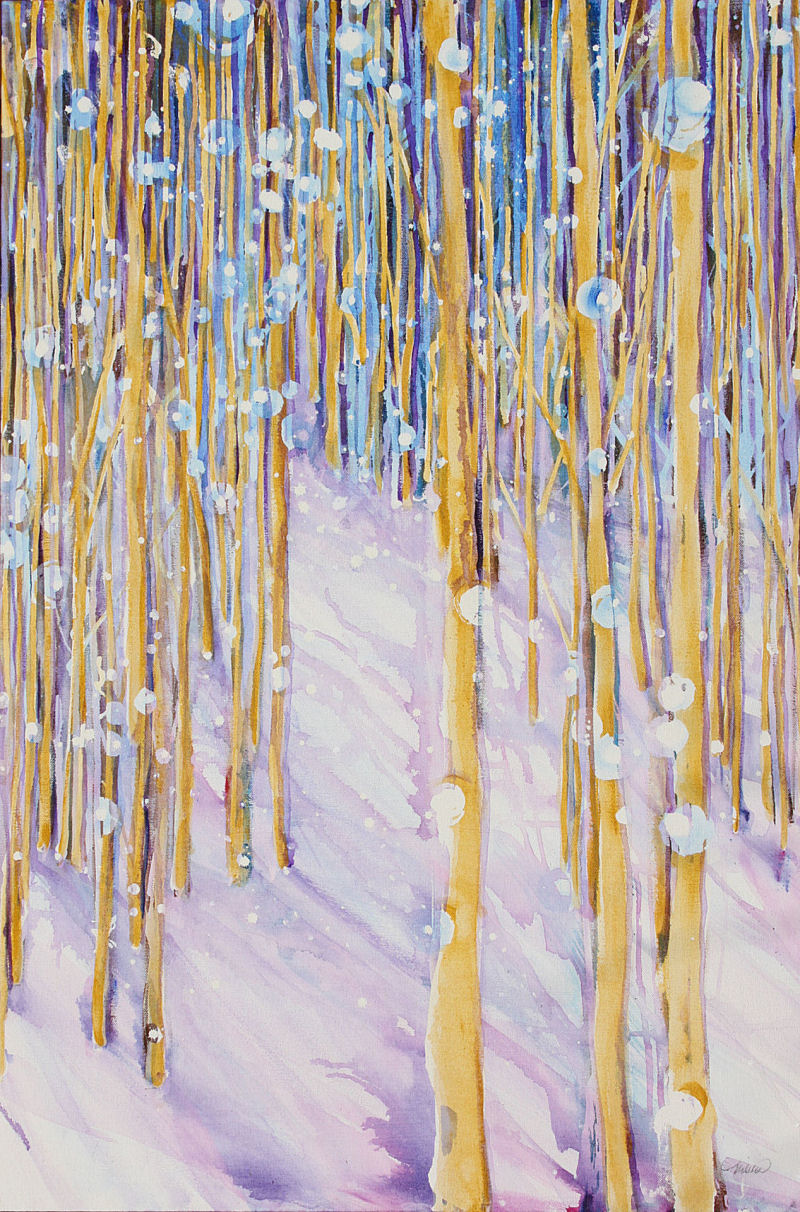 Creating Art and talking about are truly two different ways of seeing; the theory of right and left-brain thinking is matter of fact. As an Artist it takes some effort to “switch brains” and reflect on the processes and progress of work in order to accompany my Art with writing on this blog, so I’m really impressed with the mature quality of the critiques given by students at Olive Stevens Elementary School of paintings on their school Art blog every month.
Creating Art and talking about are truly two different ways of seeing; the theory of right and left-brain thinking is matter of fact. As an Artist it takes some effort to “switch brains” and reflect on the processes and progress of work in order to accompany my Art with writing on this blog, so I’m really impressed with the mature quality of the critiques given by students at Olive Stevens Elementary School of paintings on their school Art blog every month.
In collaboration with Oxide Gallery, the Denton school has started a blog where students – or anyone else actually – can give a critique of a different work of Art each month. This month the comments regard the recently finished Sounds of Silence, which is also at the gallery.
The Tree of Life Chair
Monday, November 30th, 2009
The Tree of Life, 29H x 29W x 29D inches mixed media; refurbished vintage plastic lawn chair, woven canvas strips and white glue, thin layers of drywall compound: cured, sanded, carved, acrylics paint, varnish. Durable, completely functional.
There was an interesting buildup of colors after a lot of changing colors and repainting the design many times, so the impressions of this chair are created like the other chairs in this series; ancient artifact replicas. The other chairs are listed here.
Exhibition Opening Dec. 1st
Wednesday, November 25th, 2009
Chapala Wind, 11H x 11W x 3D inches acrylics on canvas, wrapped sides painted
Upcoming exhibition: monthly featured artist at Oxide Gallery in Denton, TX. Among the items on exhibit: most of the Magic Square series, Dawn at Bell Rock, Sounds of Silence, Polypore Fungi, Shadows of Summer, Eastern White Pine, and three of the vintage chairs. Opening Reception Tuesday, December 1st, 6:00 p.m. – 8 p.m., and the show runs until December 31st.
Dawn at Bell Rock
Sunday, November 22nd, 2009
Dawn at Bell Rock, Arizona – 24H x 18W x 2D inches acrylics on canvas, wrapped sides painted, trim frame. Below: phases 01, 02 and 07
The Campsite
Wednesday, October 21st, 2009
Thumbnails: 1) Value sketch using Payne’s Gray 2) Oct 21st in progress 3) finished, left detail. This is the 2nd week of the watercolor course offered by Jo Williams.
The Campsite, Maine, USA – 15 x 22 inches Watercolors on 140 lb. acid free cold press premium paper, 22H x 28W” professionally framed, dark cherry wood with brass title plate.
500X Gallery: Landscape
Tuesday, October 6th, 2009
Saint Catherine’s Sunset, Ontario, Canada – 11H x 11W x 3D acrylics on canvas, wrapped sides painted, showingOctober 1 0 – 31st, 2009 500X Gallery Open Show: Landscape, 500 Exposition Ave. Dallas, TX. Opening Reception Saturday, October 10th, 7:00 p.m. – 10:00 p.m.
Oxide Gallery 1st Year Anniversary celebration today, Tuesday October 6th, 6:00 p.m. – 9:00 p.m. Happy Anniversary Oxide Gallery!
I’ll be giving a demo on the use of Masking Fluid in acrylics paintings, so come and reveal one painting by helping to peel off the rubberized mask – I don’t even know what it looks like underneath, so it will be a surprise for all of us. Techniques on applying the fluid will be demonstrated on another painting already in progress. Three pieces accepted in the current show at Oxide Gallery are:
What Bigleaf Maples Do At Night
Monday, May 25th, 2009
What Bigleaf Maples Do At Night, 57H x 20W x 4D inches muslin, glue, acrylics on canvas wrapped over custom-built stretcher frame. LED light system in back.
Alain, my husband, signed his name on this also, because he spent the entire week designing, soldering and wiring a system of 30 LED lights for the back. He was not impressed with the eight inadequate push-lights I was initially going to use to create this Day- Night Art. The electric source is a rechargeable 12 volt battery placed neatly in the back, with an easily accessible on-off switch in the lower left corner. He’s not thrilled to ever create another, so it looks like I’ll be learning a little about soldering and electronics, because there are plans to transform the other two canvases exactly the same size as this one. Originally l hoped it could hang in any of four orientations, but that was revised due the battery pack in the back. Thank you Alain for making this piece what it is!
______________________The original blog posts; process:___________________
Nov. 17th, 2008: While finishing the final stages of Sun Shower #4, at this point more study than stroke, I’ve started on the next piece… a bit of mystery thrown into this one just for fun. Hint: Step 1 – Unbleached muslin is painted with glue; place over top parchment paper and turn or lift frequently so it doesn’t stick. Nov. 18th: Step 2– When dry the muslin becomes stiff and can be crumpled, pinched and maneuvered to create 3D textures.
Nov 18th, aft. Step 3 – OK, enough guessing. I have three beautiful sturdy 36 x 12 x 3 inch canvases, hung vertically or horizontally. Each one will have a 3D design of life-sized leaves created with the stiff muslin. This one is of Large Leaf Maples seen on salt Spring Island, B.C. when we were there last summer. They are really this big – about 15 inches across! On these canvases, all dimensional surfaces will be considered; the front, the sides, and possibly some sticking out from the back. Everything will be primed before painting and I love Virginia’s idea to use glue as a resist for the leaf veins. In the above three images the design is still in planning stages.
Nov. 19th – A few thoughts before continuing work: this could be as simple as a sillhouette or painted realistically, still haven’t decided..maybe a compromise of the two, on the abstract side of things. Putting lights in the back could be interesting too, as in the recent Zen Garden #8 but would like to come up with something that does not have a distracting cord.
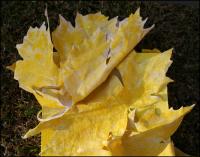 Nov.21st – Seen here, the leaves have a splotchy base coat of Hansa Yellow Deep, a color chosen because when it is so vibrant when it peeks through built up layers of other colors. Now that the entire piece has color though, I think I prefer the sculptural purity of the unpainted sillhouettes better – something to remember for similar work in the future.
Nov.21st – Seen here, the leaves have a splotchy base coat of Hansa Yellow Deep, a color chosen because when it is so vibrant when it peeks through built up layers of other colors. Now that the entire piece has color though, I think I prefer the sculptural purity of the unpainted sillhouettes better – something to remember for similar work in the future.
The weight of tinted primer and each application of acrylics makes the fabric limp from of the paint, meaning the creasing process needs to be done all over again once it dries, even on successive layers. Because of this I need to slow down and be more gentle with the painting process also. It’s funny how you can overlook things like that when you are ten steps ahead with anticipation for a new project; things always take much longer than you imagine. There is going to be a lot of stopping and starting with this one, which is exactly how overlapping projects occurs.
Also: looking forward to a day-long workshop tomorrow, learning about Encaustic painting with Deanna Wood. Encaustics is an ancient process of painting with beeswax and natural resins. Not usually a “workshop” kind of Artist because I’m too greedy with my work-time, but this is one of those things that’s best learned from an expert. Am bringing a fabric leaf to the class to see how it could be incorporated and if this entire. Large Leaf Maples piece could benefit.
______________________________
All posts and comments for this piece are now combined.
Submitted on 2008/11/18 at 11:48am
If you don’t want to see the seed bits in the muslin, you can get unbleached muslin without the seeds.
_______________________________
Submitted on 2008/11/18 at 1:03pm
OK Lynda, thanks for offering this valuable tip. With regard to what’s in mind for this project, the rawness of the fabric will provide extra texture, but others may want to know that finer quality muslin is available.
Nikki
_______________________________
Submitted on 2008/11/18 at 1:53pm
Hmmm…looks like a resist process to me. Is it a mask? You are a very adventurous soul!
Virginia Wieringa
_______________________________
Submitted on 2008/11/18 at 2:06pm
Nope, not a mask or resist…at least the glue wasn’t initially going to be used as a resist, but once again I owe thanks for the tip via a viewer’s comment – thanks Virginia! It’s true, glue can be used on anything as a paint resist, usually on wood it works similar to crackle glaze (ask me how if anyone is interested). I haven’t tried that technique on raw fabric yet though and for what I have in mind, painting extra glue in strategic places could produce some interesting effects. Let’s see…
Nikki
_______________________________
Submitted on 2008/11/19 at 1:16am
This is great Nikki. I’ll be back tomorrow to see how this project is coming along.
Jim Drury
_______________________________
Submitted on 2008/11/19 at 4:12pm
Hi Nikki
This is getting really interesting, can’t wait to see the finish project
Elizabeth
_______________________________
Submitted on 2008/11/19 at 7:07pm
Thanks for staying tuned Dad and Elizabeth, I also can’t wait to see the finished project – it’s always a mystery even if I think I know what I’m doing.
Nikki
_______________________________
Nov.27: What Large Leaf Maples Do At Night, detail images of 12 x 36 x 3 inches Muslin, glue, acrylics on wrapped canvas. As seen here I imagined the leaves glowing in the moonlight, which took me to the idea of turning it into a piece that can be viewed differently in a dark corner or at night so the sculptural sillhouette shows best.
Since Saturday’s Encaustics workshop I’d like to try another sculptural piece doing the whole thing with 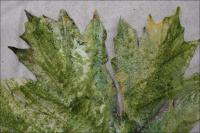 Encaustics tecniques, see right sample. Beeswax doesn’t adhere to acrylics though, so another will need to be planned with that medium in mind right from the start.
Encaustics tecniques, see right sample. Beeswax doesn’t adhere to acrylics though, so another will need to be planned with that medium in mind right from the start.


